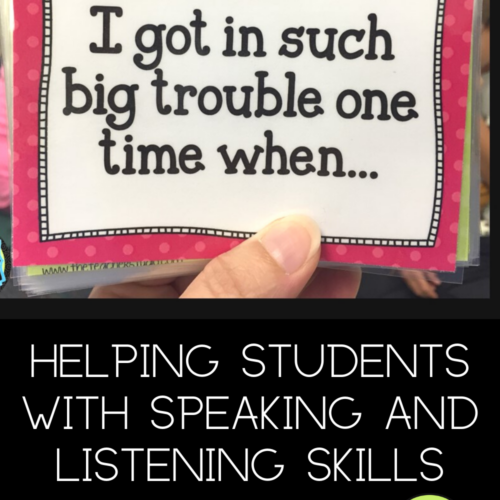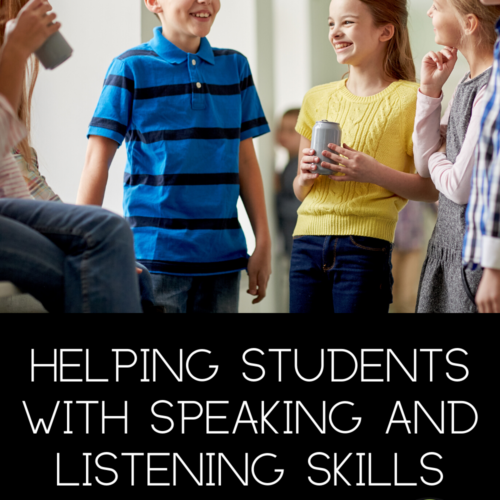





 Do you explicitly teach speaking and listening in your classroom? Many of us are familiar with the term “accountable talk” as it refers to discourse in the classroom. Many districts have begun implementing “accountable talk” initiatives. Teachers are working hard to explicitly teach students how to engage in quality educational discussions. I think most educators will be in agreement that this is a good idea. After all, we know that academic discourse can lead to amazing learning–and can improve engagement and interest. Many teachers have accountable talk “stems” or sentence starters posted and use these to help guide students through more and more sophisticated discussions. I’m a huge fan–really!
Do you explicitly teach speaking and listening in your classroom? Many of us are familiar with the term “accountable talk” as it refers to discourse in the classroom. Many districts have begun implementing “accountable talk” initiatives. Teachers are working hard to explicitly teach students how to engage in quality educational discussions. I think most educators will be in agreement that this is a good idea. After all, we know that academic discourse can lead to amazing learning–and can improve engagement and interest. Many teachers have accountable talk “stems” or sentence starters posted and use these to help guide students through more and more sophisticated discussions. I’m a huge fan–really!What is Accountable Talk?
But I sometimes stop and look at my own students and realize that, for some, we may need to back up a little from this. It’s all well and good to teach students the ins and outs of a quality discussion. Students may know WHAT to say and even be able to explain why. But there is one thing I think we sometimes forget–some students just lack the confidence to apply these new tools we are teaching them! By engaging in these discussions and saying things like, “I disagree with you because…” or “I would also like to add…”, it requires a great deal of confidence and risk-taking.
One thing I have started to do in recent years is to give students a lot more opportunities to build their oral language skills in pairs and trios…to get them used to sharing their ideas, piggybacking off of other ideas–and even disagreeing with others. By doing this in much smaller groups, the risks go down, and confidence can increase dramatically. Think about this–how often do you explicitly teach students HOW to listen? All of these are critical lessons that need to be taught.
I start small…by having partners share stories that I have on these cards. I have a whole range of topics–things that ALL students should be able to talk about for about a minute. We practice with our pairs making a comment about what the other person says…they might just compliment them…or ask a question…or make a connection…but it’s all very relaxed. I may then invite some students to share ideas with the whole class. I love to make the connection to writing–about how learning to TELL stories is the first step in WRITING stories. Students enjoy practicing this way and can relax and feel much safer than in front of the entire class…and allows me time to walk around and “coach” and make suggestions.
Practicing Our Speaking and Listening Skills
Sometimes, too, it’s fun to just throw a word or phrase out there and let the students talk! The other day, I presented this card to the class, and we practiced agreeing and disagreeing with each other in groups of three. We had people talking about their opinions about…
- roller coasters.
- personal experiences about roller coasters
- even about how they work and how dangerous they can be.
What do you notice? That’s right–writing genres! This was the perfect time to talk to students about how a simple topic like homework…or snakes…or losing…can lead to countless discussions or pieces of writing. In fact, after they had their roller coaster discussions, we first did some whole-class sharing. After that, I sent them off to their writer’s notebooks to free write on the topic for about 15 minutes. Their pencils were furiously scratching across their pages–and I know it’s because they had some amazing discussions before they wrote.
So…my students are having a lot of fun with language these days, are getting to know each other, and are building their confidence daily. As we move deeper into the school year, I know that more and more of them will be ready to chime in to class discussions. I will give them plenty of chances to really use those accountable talk stems I have hanging there!
When Do I Do This?
Because I use these so often in my class, I wanted a set to have handy. By the way, these are great fillers when you have 5 minutes! Try them while you wait for a special class…to transition in from recess…anytime! I also pick a few times throughout the year to do a more focused set of minilessons. Tying this to my reading and writing curriculum and genre studies just makes sense.
In case you are interested, I did make a nice laminated set for my class and put them in my store as well. I knew this would be SO easy for teachers to do on their own, but sometimes just having them done is so nice! I have informational topics, opinion topics, and cards geared for personal narrative stories–so I can use these with every genre of writing I teach. Here is the link if you are interested in trying some of these yourself! We do speaking and listening exercises with narratives, opinions, and content area topics. I’ve included all of these!





